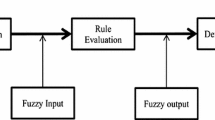Abstract
The aim of this study is not only to give self-contained and methodological steps of data mining with its areas of applications, but also to provide a compact source of reference for the researchers who want to use data mining and fuzzy inference in their area of work. We construct a fuzzy inference system to predict the profit of the major 500 industrial enterprises of Turkey. For this aim, we use most of the data mining tools. First, we use fuzzy \(c\)-means clustering algorithm and obtain the linguistic terms of the variables. Having used decision tree technique, fuzzy rules are revealed. Eventually, we compare various defuzzification strategies to obtain crisp prediction values of our fuzzy inference system. We can conclude that the prediction results of the smallest of maxima defuzzification strategy-based fuzzy inference system has circa 40 % smaller sum square error than that of classical regression model.


Similar content being viewed by others
References
Abellán J, Masegosa AR (2010) An ensemble method using creedal decision trees. Eur J Oper Res 205:218–226
Bezdek JC (1974) Cluster validity with fuzzy sets. J Cybern 3:58–73
Breiman L, Friedman J, Olshen R, Stone C (1984) Classification and regression trees. Wadsworth International Group, Monterey
Carden A (2009) Profit and production. Q J Austrian Econ 12(2):13–26
Celikyilmaz A, Turksen IB (2009) Modeling uncertainty with fuzzy logic. Springer, Berlin
Delis MD, Koutsomanoli FA, Staikouras CK, Gerogiannaki K (2009) Evaluating cost and profit efficiency: a comparison of parametric and nonparametric methodologies. Appl Financ Econ 19:191–202
Dumitrescu D, Lazzerini B, Jain LC (2000) Fuzzy sets and their applications to clustering and training. CRC Press, Florida
Duzakin E, Duzakin H (200) Measuring the performance of manufacturing firms with super slacks based model of data envelopment analysis: an application of 500 major industrial enterprises in Turkey. Eur J Oper Res 182:1412–1432
Ecer F, Ulutagay G, Nasibov EN (2011) Does foreign ownership affect financial performance? Ind Approach Middle East Financ Econ 14:152–166
Fukuyama Y, Sugeno M (1989) A new method for choosing the number of clusters for the fuzzy c-means method. In: Proceeding of the 5\(^{th}\) Fuzzy Systems Symposium, pp 247–250
Jang JSR, Sun CT, Mizutani E (1997) Neuro-fuzzy and soft computing: a computational approach to learning and machine intelligence. Prentice Hall, Upper Saddle River
Kennedy RL, Lee Y, Roy BV, Reed CD, Lippman RP (1995) Solving data mining problems through pattern recognition. Prentice Hall, Upper Saddle River
Krzysztof S (2014) Neuro-fuzzy systems with weighted attributes. Soft Comput 18(2):285–297
Kreinovich V, Mouzouris GC, Nguyen HT (1998) Fuzzy rule based modeling as a universal approximation tool. In: Nguyen HT, Sugeno M (eds) Fuzzy systems: modeling and control. Kluwer, Boston, pp 135–195
Kuosmanen T, Kortelainen M, Sipiläinen T, Cherchye L (2010) Firm and industry level profit efficiency analysis using absolute and uniform shadow prices. Eur J Oper Res 202:584–594
Korol T, Korodi A (2011) An evaluation of effectiveness of fuzzy logic model in predicting the business bankruptcy. Rom J Econ Forecast 3:92–107
Larose DT (2005) Discovering knowledge in data. Wiley, New Jersey
Lin CT, Lee CG (1996) Neural fuzzy systems. Prentice Hall, New Jersey
Liu ST (2007) A computational method for the maximization of long-run and short-run profit. Appl Math Comput 186:1104–1112
Nasibov EN (2003) Aggregation of fuzzy values in linear programming problems. Automatic control and computer sciences, pp 37, 1–11
Nguyen HT, Prasad NR, Kreinovich V, Gassoumi H (2001) Some practical applications of soft computing and data mining. In: Kandel A, Bunke H, Last M (eds) Data mining and computational intelligence. Springer, Berlin, pp 273–307
Novak V, Perfilieva I, Nguyen HT, Kreinovich V (2004) Research on advanced soft computing and its applications. Soft Comput 8:239–246
Olafsson S, Li X, Wu S (2008) Operations research and data mining. Eur J Oper Res 187:1429–1448
Olmo JL, Romero JR, Ventura S (2012) Classification rule mining using ant programming guided by grammar with multiple Pareto fronts. Soft Comput 16(12):2143–2163
Quinlan JR (1993) C4.5: programs for machine learning. Morgan-Kaufmann, San Mateo
Ulutagay G (2012) Modeling of thyroid disease: a fuzzy inference system approach. Wulfenia J 19(1):346–357
Ulutagay G, Nasibov EN (2012) Fuzzy and crisp clustering methods based on the neighborhood concept: a comprehensive review. J Intell Fuzzy Syst 10(3):1–20
Witten IH, Frank E (2005) Data mining: practical machine learning tools and techniques. Morgan-Kaufmann, San Mateo
Xie XL, Beni G (1991) A validity index for fuzzy clustering. IEEE Trans Pattern Anal Mach Intell 3:841–846
Zadeh LA (1965) Fuzzy sets. Inf Control 8:338–353
Acknowledgments
Gözde Ulutagay has been partly supported by Grant 10-183-RG/ITC/AS_C from TWAS (The Academy of Sciences for the Developing World)-COMSTECH (Committee on Scientific and Technological Cooperation).
Author information
Authors and Affiliations
Corresponding author
Additional information
Communicated by T. Allahviranloo.
Rights and permissions
About this article
Cite this article
Ulutagay, G., Ecer, F. & Nasibov, E. Performance evaluation of industrial enterprises via fuzzy inference system approach: a case study. Soft Comput 19, 449–458 (2015). https://doi.org/10.1007/s00500-014-1263-3
Published:
Issue Date:
DOI: https://doi.org/10.1007/s00500-014-1263-3




